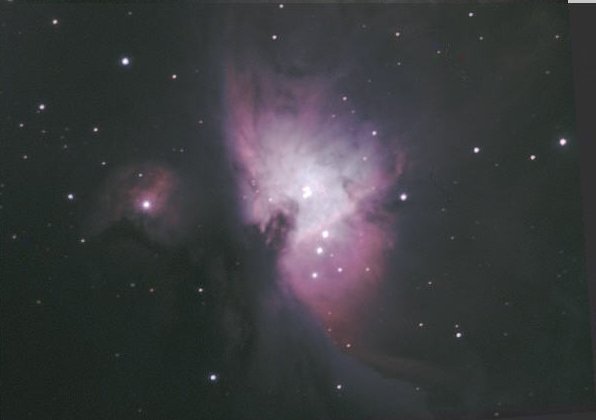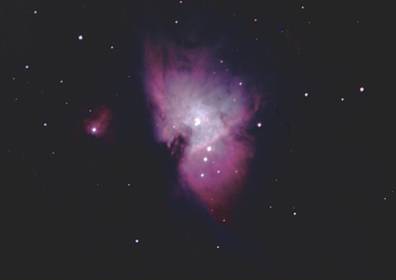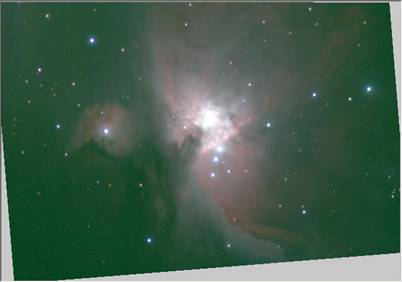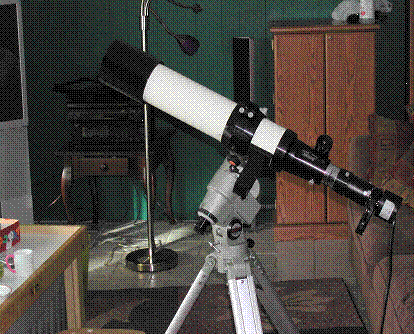


This is my second attempt to image M42, the Great Nebula in Orion. (It was taken the last week in February, 2006; I made my first image about a month ago, but its not included on this web site.) M42 is a huge object, perhaps 30 light years across, lit up by heat and ultraviolet light emitted by the small group of newly formed giant stars called the “trapezium” in the nebula’s center. (I believe many of the other visible stars are in the foreground, and not part of the object). This makes the trapezium region thousands of times brighter then the the glowing gas at the nebulas fringes, and hence the object is notoriously difficult to photograph in its entirety. The whole thing is embedded in an enormous cloud of dark interstellar gas called the Orion Molecular Cloud 1, which is hundreds of light years across but visible only in very long exposures.
To the naked eye, M42 looks like a fuzzy star on Orion’s sword. Through a small telescope, it begins to look like my picture, although it is difficult to see color because of the low brightness level (we are all effectively colorblind at low light levels). The object is described by astronomers as a huge star-forming region or “stellar nursery,” where a huge cloud of stellar gas is condensing to form hundreds of new stars (including the ones visible in the image). Much higher resolution images taken from the hubble telescope additionally show disks of dust and gas called “propolyds” forming around many of these new stars; these are believed to be embryonic solar systems. The object is believed to be about 1,600 light years distant and about 30 light years across, and covers an area of sky about the size of the full moon (only the core is visible to the naked eye). It glows rose red due to ultraviolet light given off by the new stars causing surrounding hydrogen gas to fluoresce (that rose red color is called the Hydrogen H-Alpha line).
This was the most elaborate image I have ever taken, due in large part to the huge difference in brightness between the nebula’s core and its extremities. In order to get the nebulas fringes without overexposing (or “saturating,” in digital terminology), I took two sets of images over a period of two nights. The first set of images was taken with the gain on the on-chip amplifier (the “chip” being the CCD chip at the heart of the cameras) set to zero, and using a glass “nebula filter” which is supposed to selectively darken light from artificial sources (i.e., streetlights), but seems to do a pretty good job of darkening the object being photographed as well. In addition, I took images through red, green and blue filters to allow me to reconstruct a color image using my monochrome camera. Overall, I took about 200 30 second exposures. Taking multiple identical exposures and then having the computer sum them together greatly reduces the effect of random noise in the individual “subframes.” Finally I used a program called “Registar” (and JASC Paintshop) to combine the red, green, blue and white-light images, giving me the image below.

This gives beautiful detail of the bright core region, but the fringes don’t show up at all. I repeated the whole process a few nights later, this time using a higher gain setting on my camera and losing the nebula filter. This gave me the image below, which clearly shows the nebula’s extent but the bright core is overexposed (saturated).

Finally I combined the two images (using “Registar” again) to get the final image (Registar had to rotate the second image to get it to align properly with the first).
All of my images are taken with a mid-1980’s vintage Televue Genesis Refractor. The Objective lens is 4” in diameter, and it has an effective focal length of 20”. It has four internal lenses, three made from glass and (I believe) one cut from Flourite crystal. It was designed by Al Nagler (who still returns phone calls), and built at his small factory in Pearl River, New York. It is shown with CCD camera and RGB filter wheel mounted.

For a more complete explanation on how this photograph was made, see “Shooting M42: Part 1, An Introduction to Digital Deep-Sky Photography” and “Shooting M42: Part 2, An Introduction to Digital Deep-Sky Photography.”